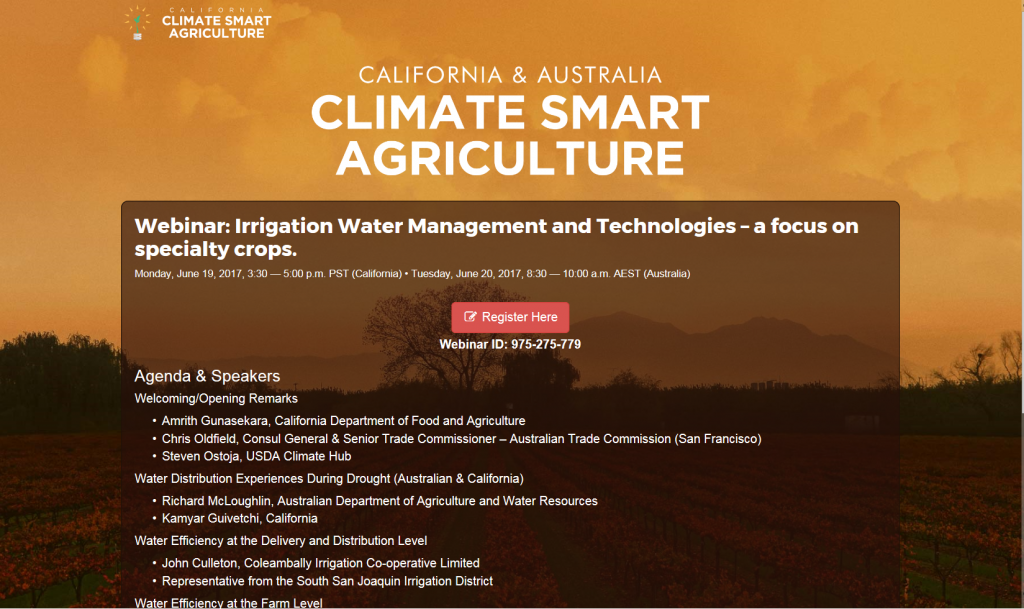-
Recent Posts
- Experience California Agriculture — Secretary Ross applauds new agritourism website from California Grown
- CDFA Celebrates Pride Month with Panel of LGBTQ+ Voices
- CDFA marches with Pride in Sacramento
- Progress for Californians: keeping invasive species at bay
- The compost connection: from your yard to California’s farms
Recent Comments
- Stacy Hackney on Despite Tariffs, California Continues Trade Engagement
- Keshav Boddula on Earth Week spotlight — CDFA Food Recovery webpage offers resources for reducing food waste
- Don’t Worry, US Investors Can Still Make Offshore Wind Happen … Somewhere – Bruce Beach CA News on California Peaches and Nectarines Arrive in Vietnam! New Export Market Opens for California Products
- US Investors Can Still Make Offshore Wind Happen…In Vietnam - Oilandinvest.com on California Peaches and Nectarines Arrive in Vietnam! New Export Market Opens for California Products
- US Investors Can Still Make Offshore Wind Happen…In Vietnam - nrinvesting.com on California Peaches and Nectarines Arrive in Vietnam! New Export Market Opens for California Products
Archives
- June 2025
- May 2025
- April 2025
- March 2025
- February 2025
- January 2025
- December 2024
- November 2024
- October 2024
- September 2024
- August 2024
- July 2024
- June 2024
- May 2024
- April 2024
- March 2024
- February 2024
- January 2024
- December 2023
- November 2023
- October 2023
- September 2023
- August 2023
- July 2023
- June 2023
- May 2023
- April 2023
- March 2023
- February 2023
- January 2023
- December 2022
- November 2022
- October 2022
- September 2022
- August 2022
- July 2022
- June 2022
- May 2022
- April 2022
- March 2022
- February 2022
- January 2022
- December 2021
- November 2021
- October 2021
- September 2021
- August 2021
- July 2021
- June 2021
- May 2021
- April 2021
- March 2021
- February 2021
- January 2021
- December 2020
- November 2020
- October 2020
- September 2020
- August 2020
- July 2020
- June 2020
- May 2020
- April 2020
- March 2020
- February 2020
- January 2020
- December 2019
- November 2019
- October 2019
- September 2019
- August 2019
- July 2019
- June 2019
- May 2019
- April 2019
- March 2019
- February 2019
- January 2019
- December 2018
- November 2018
- October 2018
- September 2018
- August 2018
- July 2018
- June 2018
- May 2018
- April 2018
- March 2018
- February 2018
- January 2018
- December 2017
- November 2017
- October 2017
- September 2017
- August 2017
- July 2017
- June 2017
- May 2017
- April 2017
- March 2017
- February 2017
- January 2017
- December 2016
- November 2016
- October 2016
- September 2016
- August 2016
- July 2016
- June 2016
- May 2016
- April 2016
- March 2016
- February 2016
- January 2016
- December 2015
- November 2015
- October 2015
- September 2015
- August 2015
- July 2015
- June 2015
- May 2015
- April 2015
- March 2015
- February 2015
- January 2015
- December 2014
- November 2014
- October 2014
- September 2014
- August 2014
- July 2014
- June 2014
- May 2014
- April 2014
- March 2014
- February 2014
- January 2014
- December 2013
- November 2013
- October 2013
- September 2013
- August 2013
- July 2013
- June 2013
- May 2013
- April 2013
- March 2013
- February 2013
- January 2013
- December 2012
- November 2012
- October 2012
- September 2012
- August 2012
- July 2012
- June 2012
- May 2012
- April 2012
- March 2012
- February 2012
- January 2012
- December 2011
- November 2011
- October 2011
- September 2011
- August 2011
- July 2011
- June 2011
Categories
- AG Vision
- Agricultural Education
- Agricultural Marketing
- Alternative Fuels
- Animal health
- Animal Welfare
- Asian Citrus Psyllid
- Biodiversity
- Border stations
- BSE
- Cannabis
- Cannella Panel
- Climate Change
- Climate Smart Agriculture
- Community-based Food System
- Conservation
- Dairy
- Drought
- Environment
- Fairs
- Farm Bill
- Farm Labor
- Farmers' Markets
- Fertilizer
- Food Access
- Food Safety
- Food Waste
- Glassy-winged Sharpshooter
- Growing California
- Healthy soils
- HLB
- Hydrogen
- Integrated Pest Management (IPM)
- Invasive Species
- Light Brown Apple Moth
- Livestock ID
- Measurement Standards
- Nutrition
- Organic agriculture
- Pierce's Disease
- Pollinators
- Specialty Crops
- State Board of Food and Agriculture
- Succession Planning
- Trade
- Uncategorized
Pages
RSS

June is fairs month – find a fair near you!
Posted in Community-based Food System, Fairs
Leave a comment
Two California Projects included in Funding for Conservation Innovation
 Two California projects are included in the mix of 33 that were recently awarded funding by the USDA Natural Resources Conservation Service (NRCS).
Two California projects are included in the mix of 33 that were recently awarded funding by the USDA Natural Resources Conservation Service (NRCS).
The agency is investing $22.6 million in projects nationwide through the competitive Conservation Innovation Grants (CIG) program. The aim is to help develop tools, technologies, and strategies to support next-generation conservation on working lands including market-based solutions to resource challenges.
Two projects for just under $2.65 million are being awarded to California ventures.

Leveraging water markets to secure water for nature and agriculture. Photo courtesy of the Nature Conservancy, California.
The California chapter of the Nature Conservancy is receiving $1,869,439 to explore market-based approaches to water management for nature and agriculture. Two initiatives in the Central Valley and in western Ventura County, will explore the use of advanced metering infrastructure to facilitate water quantity trades as part of a solution to meeting new state groundwater regulations.
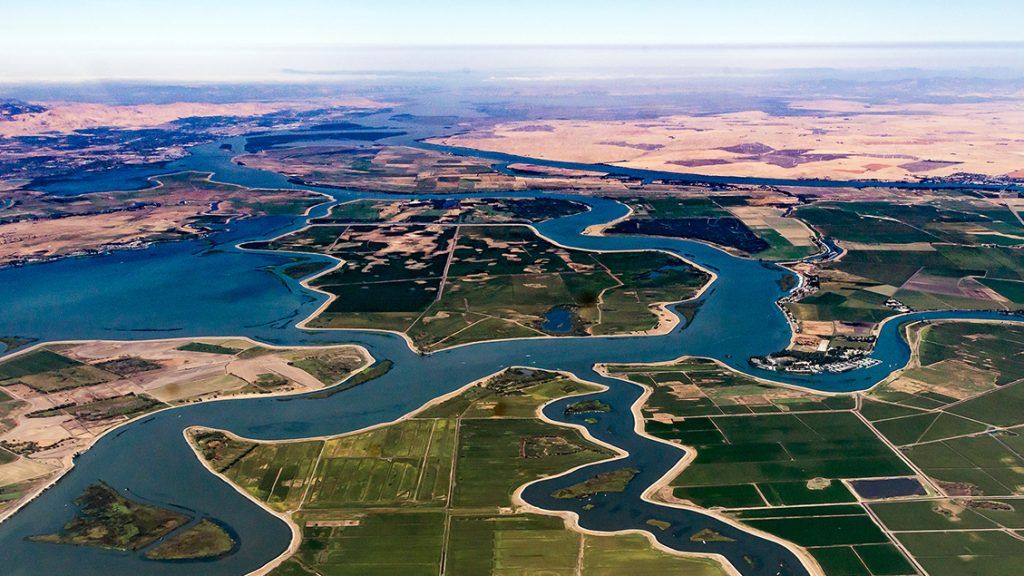
Streamlining regulatory compliance and conservation planning. Photo courtesy of the Freshwater Trust
The Freshwater Trust (TFT) is receiving $779,959 to develop an integrated planning, tracking, and adaptive management system for agricultural producers and regional coalitions in Solano County. Farmers and coalitions engaged in multi-objective programs will be able to demonstrate progress in improving surface water and groundwater quality and quantity. The completed system would be broadly transferable and will be made publicly available.
Posted in Uncategorized
Leave a comment
California & Australia: Climate Smart Agriculture Webinar – June 19th
Although California and Australia are on opposite hemispheres, our climates – and the associated challenges — are profoundly similar. As California continues to lead the nation in agricultural production, we must look to our international partners to find innovate ways to produce high quality foods while also practicing water conservation.
Join the conversation as farmers, research scientist and government representatives from Australia and California discuss irrigation water management and technologies for use in specialty crop production.
California & Australia Climate Smart Agriculture Webinar June 19, 2017 · 3:30 to 5:30 p.m. (PST)
Australia is one the world’s leaders in irrigation efficiencies and water management innovation. From 1997 to 2009, Australia faced the worst drought in the country’s history. However, through a series of policy innovations, Australia was successful in reducing water use and developing adaptive on-farm solutions for a changing climate.
California is working in collaboration with international partners to foster knowledge-sharing partnerships to address climate change impacts on agriculture. This webinar is the fifth in a series of international discussions focusing on climate smart agriculture.
Posted in Climate Change, Climate Smart Agriculture
1 Comment
Mexican migrant workers came to California to pick grapes. Now they own wineries – from the Washington Post
By Dave McIntyre, Washington Post
The Smithsonian recognizes five families who have worked their way up in the U.S. wine industry
Outside Robledo Family Winery, south of Sonoma, on a cool April Sunday, the U.S. and Mexican flags whipped a stiff salute in the wind blowing off the San Pablo Bay. A third banner bore the winery logo. The flags represent three themes central to the lives of Reynaldo Robledo and many other Mexican migrant workers who have helped shape California’s wine industry: heritage, opportunity and family.
Robledo is part of a small but growing community of Mexican American families who started as migrant workers and now have their own wineries. They have emerged from the invisible workforce of laborers who prune the vines in bitter winter cold and tend them under searing summer sun. We read about them when they collapse from heat exhaustion in California’s Central Valley or perish in a winery accident. But they rarely appear in the glossy magazines that extol the luxury wine lifestyle, except as cheerful extras in harvest photos.
Five Mexican American families are helping craft the next chapter in the story. They started as migrant workers and now have their own wineries.
They came from Michoacan or Jalisco, two agricultural provinces near Mexico City. Their fathers left for El Norte as migrant workers — some under the Bracero guest-worker program, others crossing the border illegally but gaining legal status in a time when papers were easier to come by. They worked in California’s burgeoning agricultural industry before settling in wine country. They encountered some of Napa Valley’s most celebrated winemakers and contributed to California’s wine revolution in the 1970s and 1980s, a period that saw dramatic changes in viticulture and food culture as the United States became a wine-loving nation.
“Their story is the journey,” says Steve Velasquez, associate curator at the Smithsonian Institution’s National Museum of American History, which honored the families during its annual winemakers’ fundraising dinner in May. “A journey from Mexico to the U.S. to work in agriculture, from a handful of families to a thriving community of Mexican Americans, from vineyard workers to winery owners. . . . These families represent Mexican Americans who once just supported an industry but now help shape it.”
Reynaldo Robledo
Robledo Family Winery

Reynaldo Robledo, center, came to California in 1968 to work in the fields of Napa Valley. Nearly 50 years later, he runs his own vineyard, with the help of his children. Lazaro Robledo, one of Reynaldo’s seven sons, manages the tasting room at Robledo Family Winery. Also pictured is Reynaldo Robledo’s girlfriend, Leticia Trejo. Photo by Marvin Joseph, Washington Post
Reynaldo Robledo tears up with pride as he describes how in 2003, he became the first Mexican American migrant worker in California to open his own tasting room to the public. He displays mementos of other career highlights, including those White House dinners and a 2008 visit to the winery from Mexican President Felipe Calderón.
Robledo’s story began more modestly, and he related it to me in quiet, hesitant English as we sat at a large table made of wood from his native Michoacan state while his youngest son, Lazaro, prepared to welcome the day’s first customers to Robledo Family Winery, in the Carneros region a few miles south of Sonoma.
Even as a young boy in Mexico’s agricultural Michoacan state, Reynaldo was used to being in charge. He was the oldest of 13 children whose father, grandfather and uncles spent eight months of every year working in apple orchards and vineyards in El Norte, and he assumed family responsibilities in their absence.
So as a teenager in Napa Valley, he was quick to seize opportunity, which was plentiful in those heady early years of California’s wine boom. Napa was rapidly transforming from a sleepy agricultural region of prune and walnut orchards into a viticultural powerhouse. An Italian American vineyard manager taught him how to graft vines, a skill that earned him as much as $4.75 per vine. He learned to drive a tractor. Before long he was a crew chief for a vineyard management company planting and managing thousands of acres of vineyards.
Learning the wine business literally from the ground up was not enough. Robledo dreamed of owning his own vineyards and putting his family name on a label. In 1984, he purchased a 13-acre junkyard in Carneros no one else wanted for about $126,000. He cleaned it up, planted vines and sold the grapes to Mumm Napa for sparkling wine. Today, Robledo Family Winery owns or leases 350 acres of vineyards in Carneros and Lake County.
While growing his business, Robledo was also raising a family. He married his childhood sweetheart, Maria, in 1970, and they raised seven sons and two daughters. It wasn’t all bliss and harmony. He and Maria divorced in 2012, and Reynaldo hints at some strong disagreements with his children.
“The boys didn’t understand the business,” he says. “In wine, you invest your money and you don’t see it for a few years. When people don’t understand the business, they want money right away.” Even so, in 2014 he formally turned ownership of the winery and vineyard management firm to five of his sons, including chief executive and winemaker Everardo and tasting room manager Lazaro Robledo, 64, also struggled with the clash of American culture and the patriarchal traditions he brought from Mexico.
“When we first made a sauvignon blanc, I told the family I wanted to call it Seven Brothers for my sons. That was a mistake,” he says with a laugh. “My two daughters were very angry.”
Another wine was less contentious. Los Braceros is a blend of cabernet sauvignon, syrah and merlot. “Braceros means strong arms,” Robledo explained. “A worker could bring his wife and one son. These grapes represent the family: father, mother and son.”
Amelia Morán Ceja
Ceja Vineyards

Amelia Morán Ceja of Ceja Vineyards and her daughter, Dalia. Amelia is the first Mexican American woman to be president of a California winery. Photo by Marvin Joseph, Washington Post
When young Amelia Morán moved from Jalisco, Mexico, to Rutherford, Calif., in September 1967, she worked in the vineyards after school. Her father, Felipe, was a manager for Oakville Vineyard Management, which tended the now-famous To Kalon vineyard for Robert Mondavi Winery. Mondavi, who would become the most influential vintner in California, was just in his second harvest, and the winery was not yet finished.
Amelia, 12 at the time, remembers enjoying the work and meeting a young boy her age who had just arrived from Mexico, Pedro Ceja, whom she would later marry. And she remembers liking the To Kalon cabernet.
“Pedro tells everybody I ate the grapes for the first two hours,” she says. “It’s true!”
Her other impressions of food in her new home were not positive. “It was all processed food,” she recalls. She began making her own lunches from recipes her grandmother taught her back in Mexico.
Today, Ceja is an enthusiastic ambassador for Mexican cuisine, filming instructional videos and demonstrating recipes in television appearances. “I want to take the best of Mexican culture — not the macho stuff, that’s no good — and incorporate it with the best from my adopted country,” she says.
Ceja, 61, is the first Mexican American woman to be president of a California winery. She co-founded Ceja Vineyards in 1999 with Pedro and his brother, Armando, the winemaker. They own or lease 150 acres in Napa and Sonoma counties and plan to break ground this year on a winery on their property in the Napa section of Carneros.
Two years ago, Ceja lobbied in Washington for revisions in worker protection regulations that had not been updated since 1992. Her activism grew out of the turbulent labor movement of the 1970s led by Cesar Chavez, who would stay with her family when her father was president of the local United Farm Workers chapter. “I marched with them on Route 29,” she recalls.
“People understood that in order to live a life of dignity, they needed the support of someone to advocate for them,” Ceja says. “Even today, the farmworkers are invisible, and we need to advocate for them. Through our wines we are paying homage to the true artists of wine — the workers.”
Though still a young winery, Ceja Vineyards is preparing for generational change. Amelia’s three children are all involved; Dalia Ceja, with an executive MBA, is sales and marketing director, and Armando’s daughter is assistant winemaker.
“There is an expression in Spanish, ‘Aun hay mas,’ ” Ceja says. “There is much more to come.”
Continue the article and meet three additional wine families here.
In addition, here’s a Growing California video featuring Ceja wines – ‘Love on the Vine’
Posted in Uncategorized
Leave a comment
Farms + Data: Most California farms are family-run, and farmers are aging
Who’s on the California farm?
From 1980 to today, California’s population has grown from 23.7 million to more than 39 million. That’s up 65 percent – and the vast majority of those folks are in urban and suburban areas. Our rural population remains well under one million in California by USDA’s measure and has grown at a slower rate than the more urbanized areas, about 46 percent over the same period.
95 percent of California’s 77,400 farms are family-owned. Non-family corporations make up just 1.3 percent of farms in California. The remainder, 3.6 percent, are operated as cooperatives, estates, trusts, institutions, etc.
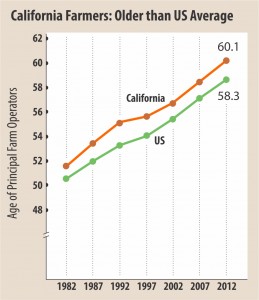 The average age of a California farmer rose from 56.8 years in 2002 to 60.1 in 2012. That’s a year and a half older than the national average of 58.3 years. More of those farmers are diversifying their businesses and/or working multiple jobs, too – 54.5 percent of operators listed “farming” as their principal operation in 2012, compared to 61.7 percent in 2002.
The average age of a California farmer rose from 56.8 years in 2002 to 60.1 in 2012. That’s a year and a half older than the national average of 58.3 years. More of those farmers are diversifying their businesses and/or working multiple jobs, too – 54.5 percent of operators listed “farming” as their principal operation in 2012, compared to 61.7 percent in 2002.
The number of men working as “principal farm operators” in California has decreased from 67,016 in 2002 to 63,873 in 2012.
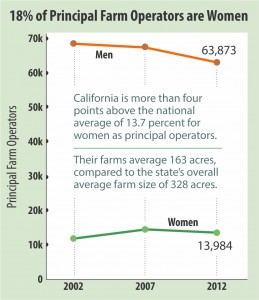 Source: USDA Ag Census data, National Agricultural Statistics Service (NASS)
Source: USDA Ag Census data, National Agricultural Statistics Service (NASS)
Posted in Agricultural Education
2 Comments
To Fight Climate Change, Heal the Ground – From the NY Times
California Today: To Fight Climate Change, Heal the Ground
By:Mike McPhate
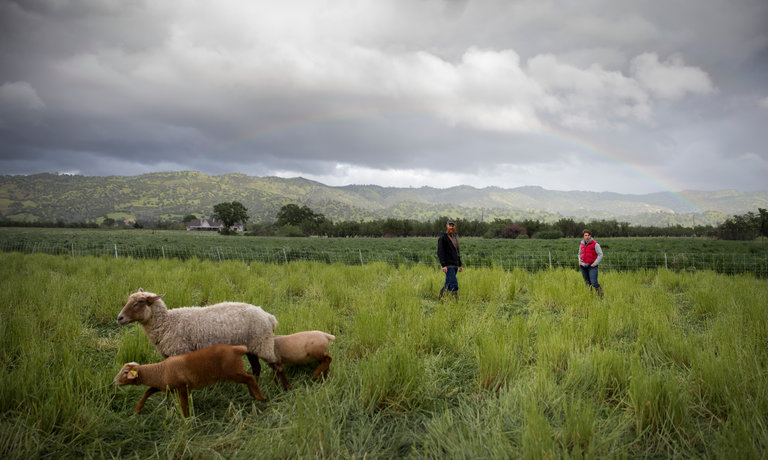
Sheep grazed at a field planted with a cover crop at Skyelark Ranch in Brooks, in Yolo County. California is encouraging farmers to strengthen their soils to help draw more carbon into the ground. Credit Joe Proudman
The climate change fight has focused largely on cutting emissions.
But California is now considering another solution: dirt.
Whereas an overabundance of carbon in the air has been disrupting our climate, plants are hungry for the stuff.
The Central Valley’s farmlands essentially operate as a vast lung, breathing in carbon dioxide through photosynthesis and converting it into plant tissues. That results in less of the heat-trapping gas in the atmosphere.
But the healthier the soil, the more carbon is stored in plants.
Enter California’s Healthy Soils Initiative, a statewide program rolling out this summer that is the first of its kind in the country.
“I think there’s a growing recognition that the soil beneath our feet has huge potential to sequester carbon,” said Karen Ross, secretary of the state’s Department of Food and Agriculture.
More than a quarter of California’s landmass is used for agriculture. Over generations, farming practices like monocropping and tillage have reduced the amount of organic matter in the soil, affecting plant growth. Some of that organic matter, which contains carbon, needs to be put back.
“If you don’t put carbon back in, you’re kind of mining the soil,” said Kate Scow, a professor of soil science at the University of California, Davis.
California’s initiative will give grants to farmers who take steps to reverse that nutrient loss. Those could include adding compost on rangelands or seeding fields between harvests with so-called cover crops such as grasses and mustards, which add organic matter to the soil.
State officials say such measures could eliminate from the air the equivalent of millions of tons of carbon dioxide a year.
For now, the soils initiative is funded with just $7.5 million, a drop in the bucket for a state with more than 76,000 farms. But officials hope it can be expanded after demonstrating enough interest from farmers.
To that end, they’ve pushed the program as a win-win by citing evidence showing healthy soils produce higher yields.
But many unknowns still need to be sorted out, said Cynthia Cory, director of environmental affairs for the California Farm Bureau Federation.
California agricultural is dizzyingly varied. More than 230 crops spring from the Central Valley alone.
Even if the new measures are good for yields, whether they justify a farm’s time, labor and expense depends on its unique circumstances.
“We want to try it,” Ms. Cory said. “I don’t know if bad or good is the question. It’s just, ‘Is it worth it?’”
Secretary Ross with 2016-2017 Executive Fellows
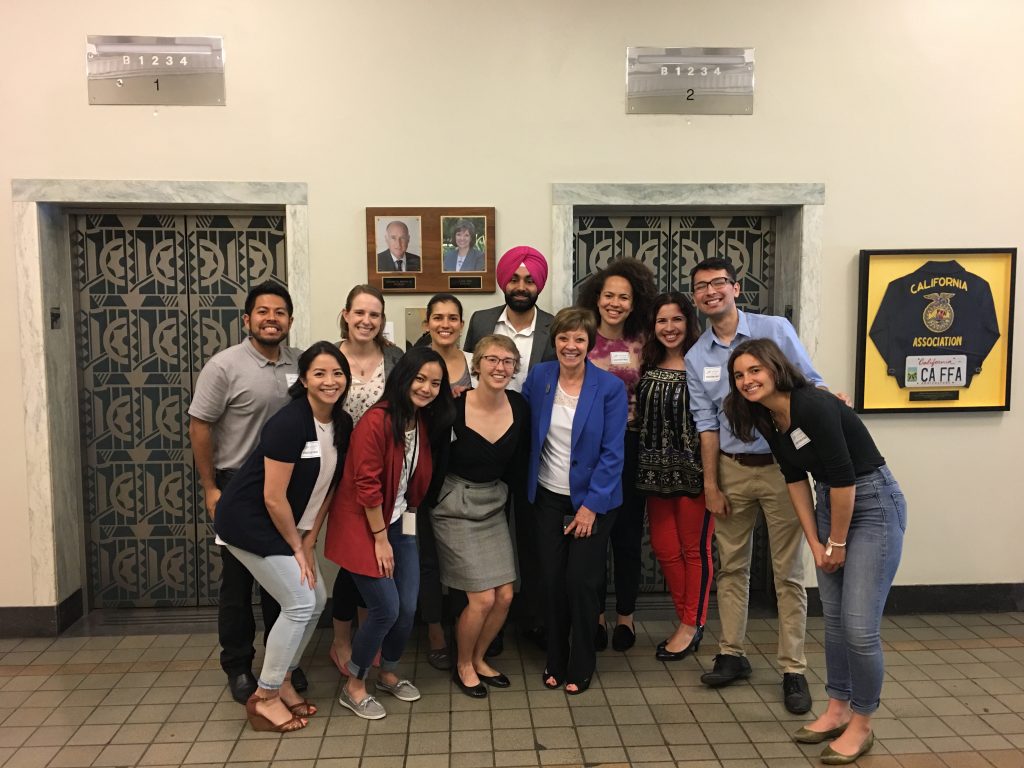
CDFA Secretary Karen Ross met today with the 2016-2017 class of state government executive fellows. The group discussed a wide range of issues, including state and federal agricultural policy, leadership strategies, and opportunities for millennials in public service. The Executive Fellowship Program is sponsored by the Center for California Studies at California State University, Sacramento and the Office of the Governor. Each of the fellows is currently serving an internship at a state agency. From left, Carlos Aguilera, Government Operations Agency; Lorine Cheung, Department of Business Oversight; Kaitlin Meyer, California Volunteers; Jenny Nguyen, Department of Public Health; Claudia Espinoza, Cal Recycle; Annika Deurlington, Department of Finance; Jaydeep Singh, CDFA; Secretary Ross; Coral Abbott, Strategic Growth Council; Patricia Vazquez, Labor and Workforce Development Agency; Jesus Flores, Strategic Growth Council; Emma Johnston, Natural Resources Agency.
Posted in Uncategorized
5 Comments
First commercial carbon-capture machine redirects CO2 to greenhouse for vegetable production – from Smithsonian.com
By Jason Daley
The Swiss company Climeworks this week switched on its first carbon capture plant—a machine designed to remove carbon dioxide from the atmosphere. The company hopes to quickly scale up its technology and capture one percent of the global carbon dioxide produced by burning fossil fuels by 2025, reports Bobby Magill for Climate Central.
The company estimates that the plant will remove some 900 tons of CO2 from the atmosphere every year—a tiny fraction of the 10 gigtons that the Intergovernmental Panel on Climate Change determined must be drawn down each year to halt global warming, writes Tereza Pultarova for Live Science.
Located near the Swiss village of Hinwil on the roof of a garbage incinerator, the direct air capture technology uses a proprietary filter to absorb atmospheric CO2 as it passes through the plant, according to a press release. Once the filter is saturated, it is heated to 100 degrees Celsius, causing it to release the gas. The CO2 is then redirected to a greenhouse where it will help grow vegetables like tomatoes and cucumbers. The carbon boost could improve the lettuce harvest by up to 20 percent, according to the company’s website.
To achieve their goal of one percent, the company estimates they will need 250,000 plants the same size as the Hinwil unit, Magill reports.
Though the plant doesn’t result in net negative emissions, it is recycling the carbon dioxide for other uses, Magill writes. In order to actually achieve negative emissions the removed CO2 would have to be sequestered via capture in underground chambers or transformation into substances like rock.
In the future, the technology could also be used to capture and sequester carbon dioxide. But for now, the plant is giving CO2 emissions a function, rather than simply letting them go in the atmosphere. The company also sees potential in selling the captured CO2 to the beverage industry to carbonize drinks or producing a renewable hydrocarbon fuel.
“CO2 capture from air has been a very controversial topic in research for a long time,” Valentin Gutknecht, a business development manager at Climeworks tells Pultarova. “There was a belief that the cost can’t get down below $600 per ton of CO2 even at the mass scale. But we have managed to break this barrier.” As Magill reports, the company hopes to get the price down to about $400 per ton.
But the technology is controversial for more than its cost. Last year, leading climate scientists, including Glen Peters, published a paper in the journal Science arguing that the nascent technology directs focus away from reducing overall emissions. And it could cause complacency in some global leaders who believe that a future technological breakthrough could readily solve the climate crisis.
But Climeworks co-founder Christoph Gebald has no scruples about his project, he tells Magill. With effects due to climate change increasingly apparent, we need to use all tools possible to clean up global emissions.
Posted in Uncategorized
Leave a comment
Warming could push Earth’s rains northward – from Climate Central
By Andrea Thompson
The Earth’s rising temperature is expected to knock the global water cycle out of whack, but exactly how it will change is uncertain. Scientists, though, can look for clues as to what the future might bring in the major climate swings that have happened in the past.
A new study that does just that suggests that Earth’s rain belts could be pushed northward as the Northern Hemisphere heats up faster than the Southern Hemisphere. That shift would happen in concert with the longstanding expectation for already wet areas to see more rain and for dry ones to become more arid.
The study, detailed Wednesday in the journal Science Advances, “adds to the large body of evidence that climate change is going to mess with the large-scale motions of air and water in the atmosphere. And this matters, because those patterns largely determine where it’s rainy or arid, broadly speaking,” NASA climate scientist Kate Marvel, who wasn’t involved with the study, said in an email.
These changes in rain distribution could have implications for future water resources, particularly in areas where water supplies are already stressed, such as the western U.S. and parts of Africa.
From the basic physics of the atmosphere, scientists expect that as the planet heats up from ever-mounting levels of greenhouse gases, net global precipitation will increase because a warmer atmosphere holds more moisture. But that increase won’t be uniform and is likely to be concentrated in the already moist tropics. And because higher temperatures also increase evaporation, other areas, such as the already dry subtropics, are likely to dry out further.
But which regions are wet and dry are also determined by the locations of the Earth’s main rain belts. The positions of those rain belts, in turn, are tied to that of the so-called thermal equator (the ring around the planet’s middle where surface temperatures are highest). And the location of that equator is impacted by the balance of temperatures between the Northern and Southern hemispheres.
Because the Northern Hemisphere has more landmass, it is heating up faster than the Southern Hemisphere, and, as some climate models have suggested, this could push the thermal equator northward, and along with it those key rain belts.
Aaron Putnam, a paleoclimatologist at the University of Maine, and Wally Broecker, a Columbia University climate scientist, looked for clues as to whether such shifts have happened before in various paleoclimate records, including the shorelines of ancient lakes and cave stalagmites.
The lakes they examined are so-called closed-basin lakes, which have rivers feeding into them, but not draining them, meaning that changes in lake levels are governed solely by precipitation and evaporation.
During the Last Glacial Maximum when the Earth was much colder, closed-basin lakes in currently dry parts of western North America, the Middle East and South America were much larger than they are now, as evidenced by radiocarbon dating and other testing of their ancient shorelines. The precursor of Utah’s Great Salt Lake, for example, was more than 11 times larger than the current lake.
Studies of the dynamics of these lakes point to increased precipitation in these regions as the likely reason these lakes reached such massive extents. This suggests more precipitation fell away from the tropics in a colder climate, the opposite of what is expected as the world warms.
Those same lakes, along with other evidence from around the world, also points to the shifting of rain belts after a rapid loss of Arctic sea ice about 14,600 years ago that saw the Northern Hemisphere heat up faster than the Southern.
Layers of sediment off the coast of South America, for example, show changes in the amount of rain-fueled river water dumping into the ocean, while cave stalagmites, which need an influx of mineral-laden rainwater to grow, also show changes in precipitation over time.
These and other paleoclimate records indicate that rain belts shifted northward along with the thermal equator because of the global heat imbalance. Over the western U.S., for example, the Pacific subtropical jet went from providing moisture to southern California and the Great Basin during the glacial era to dumping it over northern California and Oregon as it does today.
While the warming happening now has a different cause than the past periods they studied, the authors think this past change could be a guide to the future and that same Pacific subtropical jet could move further north still.
Kevin Trenbeth, a climate scientist at the National Center for Atmospheric Research in Boulder, Colo., said the study didn’t account for changes in sea surface temperatures, which are the main drivers of changes in the position of the rain belts (as is seen during an El Nino event, when Pacific warming pushes the subtropical jet over the Western U.S. southward). Trenberth was also not involved in the study.
Putnam said the study was more focused on how the difference in warming between the hemispheres impacted the rain belts.
The changes in rain dynamics could also depend on the seasons, as climate records over recent decades suggest that the difference in heating between the two hemispheres is most pronounced during the Northern Hemisphere, or boreal, winter.
What this could mean, the authors posit, is that as the boreal winter continues to warm disproportionately, the thermal equator and therefore the rain belts won’t travel as far south as they currently do during the winter. This could have major impacts on areas, such as the western U.S., which get the bulk of their rain during the winter.
Conversely, in the boreal summer, when the difference between the two hemispheres isn’t as great, the “wet get wetter, dry get drier” effect of warming will dominate, meaning more rain in the tropics and less in the subtropics.
Of course, like any single study, this one is far from the final say. “This will evolve,” Putnam said, as more paleoclimate records emerge and are paired with climate models to “try to see if climate models can reproduce the patterns that we see in those datasets.”
Posted in Uncategorized
Leave a comment
Targeting Food Waste: $5 million available for prevention/rescue grants
 CalRecycle (a.k.a. the California Department of Resources Recycling and Recovery) has announced a new grant program targeting food waste. The Food Waste Prevention and Rescue Grant Program aims to lower overall greenhouse gas emissions by establishing/expanding food waste prevention and/or rescue projects in California to reduce the amount of food being disposed of in landfills.
CalRecycle (a.k.a. the California Department of Resources Recycling and Recovery) has announced a new grant program targeting food waste. The Food Waste Prevention and Rescue Grant Program aims to lower overall greenhouse gas emissions by establishing/expanding food waste prevention and/or rescue projects in California to reduce the amount of food being disposed of in landfills.
Projects
Eligible projects include:
- Food waste prevention projects that prevent food waste from being generated and becoming waste normally destined for landfills, with any food waste residuals from the project being sent to composting or digestion when available within the project service area.
- Food rescue projects that result in rescued food being distributed to people, with any food waste residuals from the project being sent to composting or digestion when available with the project service area.
Funding
$5,000,000 is available for fiscal year (FY) 2016-17. The funding will be distributed as follows:
- Large Tier: $4,000,000 allocation for large tier projects with minimum grant award of $100,001 and a maximum grant award of $500,000 per application.
- Small Tier: $1,000,000 allocation for small tier projects with minimum grant award of $25,000 and a maximum grant award of $100,000 per application.
For information about eligibility and other details on this competitive grant program, see the notice on the CalRecycle site.
The Food Waste Prevention and Rescue Grant Program is part of California Climate Investments, a statewide program that puts billions of Cap-and-Trade dollars to work reducing greenhouse gas emissions, strengthening the economy and improving public health and the environment—particularly in disadvantaged communities.The Cap-and-Trade program also creates a financial incentive for industries to invest in clean technologies and develop innovative ways to reduce pollution. California Climate Investment projects include affordable housing, renewable energy, public transportation, zero-emission vehicles, environmental restoration, more sustainable agriculture, recycling and much more. At least 35 percent of these investments are made in disadvantaged and low-income communities. For more information, visit California Climate Investments.
Posted in Climate Change, Environment
3 Comments



